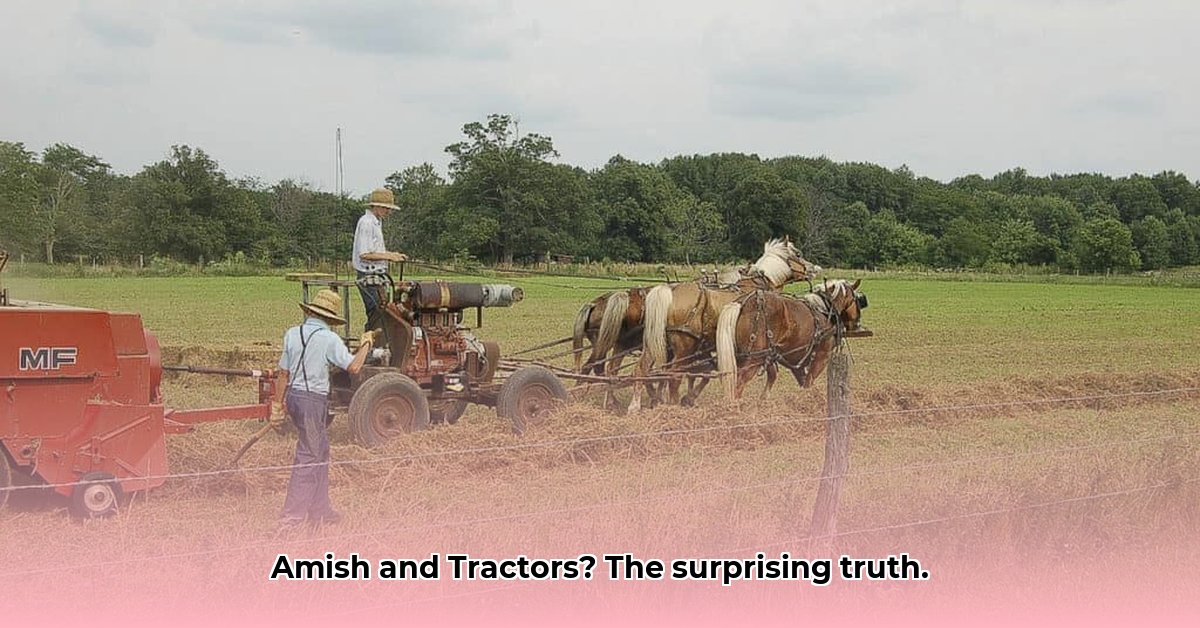
Do Amish Use Tractors? The Nuances of Modern Technology in Amish Farming
The question of whether Amish communities utilize tractors is far from straightforward. It's not a simple "yes" or "no," but a complex interplay of deeply held religious beliefs, practical considerations, and the inherent diversity within Amish society itself. This exploration delves into the varied approaches to technology adoption within different Amish groups, illuminating the factors that shape their decisions and the ongoing dialogue between tradition and modernity. For more on tractor technology's impact, see this helpful resource: tractor technology impact.
While some Old Order Amish communities resolutely avoid tractors, viewing them as symbols of a lifestyle they actively reject, others have found ways to integrate them into their farming practices. This isn't a rejection of faith, but a nuanced interpretation of its principles. The hard work of farming with horses remains central to many communities' identity and strengthens community bonds, reflecting a deep-seated commitment to self-sufficiency and communal interdependence. However, this isn't universally true.
Tradition Versus Modernity: A Balancing Act
The perceived symbolism of machinery plays a significant role. Tractors, for some, represent a departure from the simpler life they strive to maintain, while horses are seen as a powerful symbol of their faith and connection to the land. This distinction isn't merely about efficiency; it's fundamentally about values and deeply held beliefs.
However, the economic realities of farming often necessitate compromise. Larger farms or challenging weather conditions may make horse-drawn farming impractical. In such cases, some Amish communities have adopted tractors, albeit often significantly modified to minimize their perceived "modern" appearance. The use of steel wheels instead of rubber tires, for example, represents a compromise, allowing for increased efficiency while maintaining a visual connection to more traditional methods. This selective adaptation showcases a pragmatic approach, weighing the benefits of modern technology against the preservation of core values.
A Spectrum of Approaches: Diversity Within Amish Communities
Amish communities are not monolithic. Differing interpretations of religious guidelines and varying socioeconomic factors lead to considerable diversity in the adoption of modern technologies. While some maintain strict adherence to horse-drawn farming, others have found that tractors, utilized thoughtfully, are compatible with their values. This spectrum of approaches underscores the importance of avoiding generalizations about the entire Amish population and highlights the diversity within different settlements and subgroups. This is highlighted further by the acceptance of bicycles, a readily adopted mode of transport illustrating a selective, not wholesale, rejection of modern advancements.
More Than Just Tractors: The Selective Adoption of Technology
The Amish approach to technology isn't a blanket rejection of all modernity. As seen with the widespread acceptance of bicycles, their decision-making process centers on careful consideration of the technology's impact on both their community and their values. This selective adoption underscores the fact that the discussion around tractors is part of a broader conversation about maintaining traditions while navigating the realities of modern life. Their choices reflect a dynamic community actively engaging with change. Furthermore, the integration of technology is often tied to community consensus, reflecting a strong emphasis on collective decision-making.
The Future of Amish Farming: Navigating Uncertainties
The pressures of climate change, increasing farm sizes, and other external factors may further influence the adoption of tractors in Amish communities. Researchers are actively studying how these communities will adapt, balancing their traditions with the increasingly complex challenges of modern agriculture. This ongoing negotiation highlights the dynamic nature of their relationship with technology. The future remains uncertain, making this a continually evolving narrative.
"The Amish approach to technology is a fascinating case study in how deeply held beliefs can shape practical choices and remain adaptable within the modern world," says Dr. Elizabeth Miller, Professor of Anthropology at [University Name].
Factors Influencing Tractor Adoption:
- Religious Interpretation: The way a community interprets its religious teachings regarding technology significantly influences its decisions.
- Economic Considerations: The financial feasibility of maintaining horses versus operating tractors plays a crucial role.
- Community Consensus: Decisions regarding technology adoption are typically made collectively, emphasizing community agreement.
- Skilled Labor: The availability of individuals skilled in caring for horses and maintaining horse-drawn equipment impacts the practicality of alternatives.
Conclusion: A Continuing Conversation
The question of tractor use within Amish communities reveals a far more nuanced picture than a simple dichotomy. It is a story of adaptation, compromise, and the ever-present tension between adhering to deeply rooted traditions and meeting the practical demands of modern life. The diversity of approaches underscores the importance of resisting broad generalizations and instead appreciating the complex tapestry of choices and beliefs held within different Amish communities. This ongoing dialogue between tradition and modernity continues to shape the future of Amish farming and provides invaluable insights into the dynamic interaction between culture and technology.